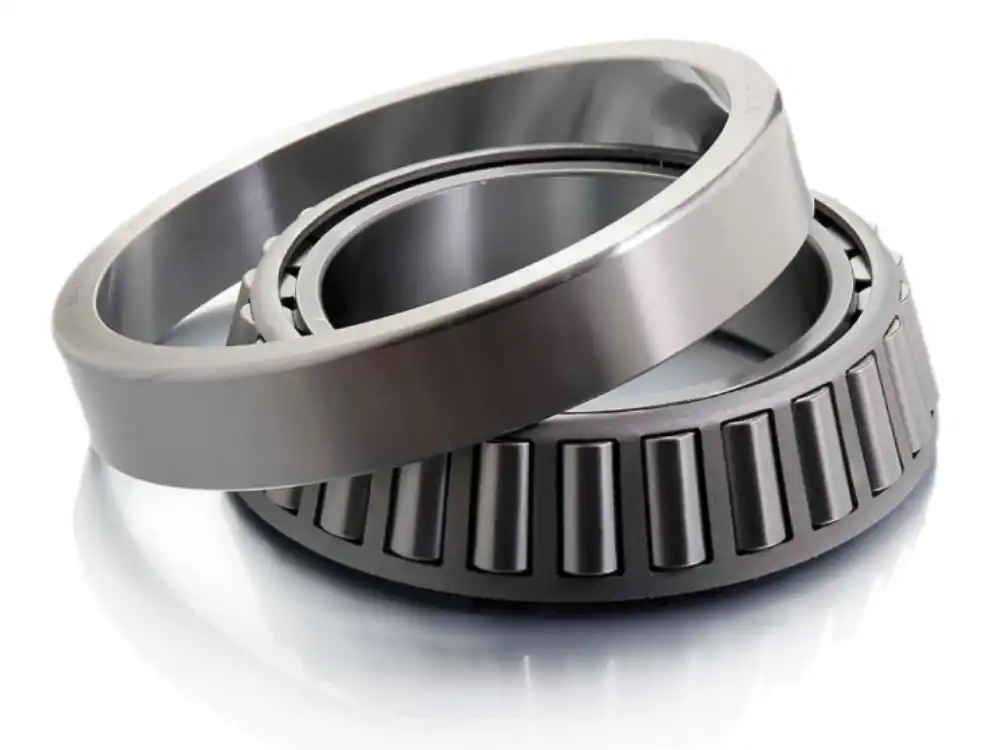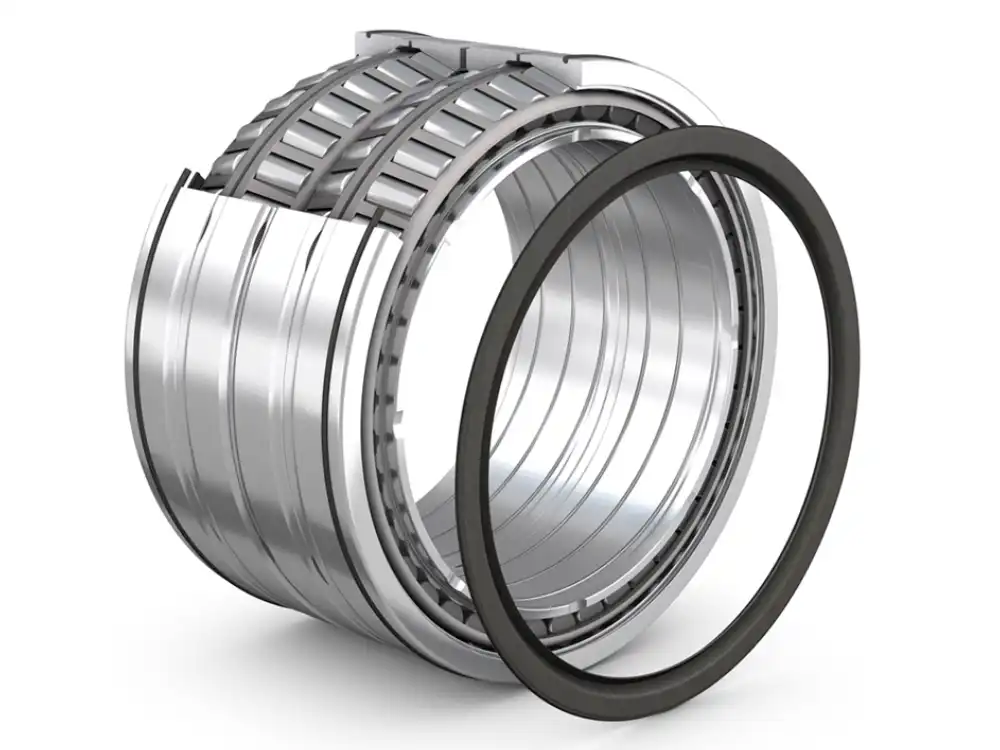What are the Load Capacities of Conical Roller Bearings?
Conical roller bearings, with their tapered inner and outer ring raceways and conical rollers, are designed to handle substantial combined loads. These bearings excel in applications requiring high load capacities, precise alignment, and durability under challenging conditions. Their unique geometry effectively distributes forces across contact surfaces, maximizing load-bearing capabilities while minimizing wear.
How do conical roller bearings handle different types of loads?

Understanding the Design Principles Behind Load Distribution
Conical roller bearings feature a distinctive tapered design that fundamentally influences their load-handling capabilities. The conical geometry creates line contact between rollers and raceways, distributing pressure over a larger surface area compared to point contact bearings. The contact angle—typically between 10° and 30°—determines the bearing's capacity ratio between radial and axial loads. A smaller contact angle prioritizes radial load capacity, while a larger angle enhances axial load handling.
The internal design incorporates cage structures that maintain proper roller spacing and orientation, preventing roller skewing and ensuring optimal load distribution. Additionally, the tapered configuration creates a separating force under radial loading, which must be counteracted either by mounting bearings in opposition or through additional components.
Manufacturing precision significantly impacts load capacity. Premium-grade bearings feature polished surfaces with controlled micro-geometry to optimize contact patterns, ensuring uniform load distribution even under extreme conditions.
Comparing Radial vs. Axial Load Capacities
Conical roller bearings can handle both radial and axial loads simultaneously, though their capacity differs depending on force direction. The radial load capacity typically exceeds that of comparable ball bearings due to the line contact between rollers and raceways. Bearings with smaller contact angles (10-15°) maximize radial load capacity at the expense of axial capacity.
The axial load capacity is determined largely by the contact angle and effective roller-raceway contact area. Bearings with larger contact angles (25-30°) significantly increase axial load ratings while maintaining adequate radial capacity. When comparing to other bearing types, conical roller bearings' axial load capacity often exceeds that of cylindrical roller bearings.

Dynamic load ratings reflect bearing capacity under movement, while static load ratings indicate capacity when stationary. For conical roller bearings, the dynamic radial load rating (Cr) and dynamic axial load rating (Ca) are interrelated through the contact angle, with Ca typically calculated as Cr × tan(α).
Factors Affecting Maximum Load Capacity
Operating temperature significantly influences maximum load capacity. High-quality conical roller bearings maintain dimensional stability and mechanical properties up to approximately 120°C without significant degradation. Beyond this threshold, specialized materials may be necessary. Engineers must apply derating factors for elevated temperature applications.
Lubrication quality directly affects the ability to achieve theoretical maximum load capacities. Proper lubrication creates an elasto-hydrodynamic film that separates rolling elements from raceways, preventing metal-to-metal contact. The viscosity and additives must match the application's operating conditions. Modern lubricants for conical roller bearings often contain extreme pressure additives that maintain film strength under heavy loads.
Installation precision and maintenance practices determine whether a bearing will achieve its designed maximum load capacity. Even minor misalignment can reduce effective load capacity by creating uneven load distribution. Proper preload or clearance setting directly influences load capacity utilization. Regular monitoring through vibration analysis or temperature monitoring helps maintain optimal performance by detecting early signs of degradation.
What makes conical roller bearings suitable for high-load applications?
Material Composition and Manufacturing Precision
Premium conical roller bearings typically utilize through-hardened or case-hardened bearing steel with precisely controlled alloying elements. Common materials like AISI 52100 chromium steel create an optimal balance between hardness and toughness after heat treatment. This allows bearings to maintain dimensional stability under heavy loads while resisting deformation.
Manufacturing precision is critical in maximizing load capacity. Modern production techniques employ CNC grinding operations capable of achieving tight tolerances and excellent surface finish. This precision ensures that contact stress distributes evenly across the roller-raceway interface rather than concentrating at high points.
Heat treatment processes develop the optimal microstructure within the bearing steel. Sophisticated protocols, including controlled heating, quenching, and tempering cycles, create a microstructure of tempered martensite with distributed carbides providing both hardness and wear resistance. These material science applications enable conical roller bearings to withstand immense forces in heavy machinery.

Geometric Advantages for Load Distribution
The tapered geometry provides significant advantages for load distribution. Unlike cylindrical bearings with purely linear contact, the conical configuration accommodates both radial and axial forces. The contact angle serves as the primary determinant of force distribution, allowing engineers to select specific angles to match application requirements.
The roller profile represents another critical geometric advantage. High-performance variants incorporate sophisticated profiles that optimize contact patterns under various loading conditions. These specialized profiles compensate for elastic deformation to maintain optimal contact rather than allowing edge loading that would reduce effective capacity.
Raceway geometry and finish quality complement the load distribution capabilities. The precise angle, curvature, and micro-geometry must perfectly complement the roller design. Surface finish quality ensures that lubricant films can effectively form and maintain separation between metal surfaces even under boundary lubrication conditions.
Performance in Extreme Operating Conditions
Conical roller bearings demonstrate exceptional resilience under shock loads and impact forces. Their robust design combines substantial cross-sections, precision-engineered geometries, and high-strength materials to absorb sudden energy inputs without catastrophic damage. The larger contact area distributes impact forces over greater surfaces, reducing peak stresses.
In contaminated environments, conical roller bearings offer superior performance. The positive guidance provided by tapered raceways helps maintain proper roller positioning even when contaminants enter the bearing. Enhanced sealing solutions, from contact seals to labyrinth seals, protect critical surfaces from contamination.
Temperature extremes challenge bearing performance by altering material properties and affecting lubrication. Bearings designed for high-temperature environments utilize heat-stabilized steels that maintain dimensional stability at elevated temperatures. For extreme cold applications, special low-temperature lubricants and modified internal clearances accommodate thermal contraction.
How should you select the right conical roller bearing based on load requirements?
Calculating Required Load Ratings for Specific Applications
Determining appropriate load ratings begins with analyzing the application's operating parameters. Engineers must identify the magnitude, direction, and nature of forces acting on the bearing positions. The basic dynamic load rating (C) represents the constant radial load that identical bearings can endure for one million revolutions.
The equivalent dynamic bearing load (P) combines radial and axial forces into a single figure measured against a bearing's dynamic load rating. For conical roller bearings, this is expressed as: P = X × Fr + Y × Fa, where Fr is the radial load, Fa is the axial load, and X and Y are factors determined by the bearing's geometry and the ratio of axial to radial loading.
Life expectation calculations represent the final component in sizing bearings for specific requirements. The L10 life represents the number of revolutions that 90% of identical bearings will complete before showing fatigue failure. For conical roller bearings, this follows the equation: L10 = (C/P)10/3.
Interpreting Manufacturer Specifications and Load Charts
Manufacturer catalogs contain standardized information to facilitate selection based on load requirements. The basic static load rating (C0) indicates the maximum static load a bearing can endure without permanent deformation. The basic dynamic load rating (C) represents the load at which a bearing achieves a basic rating life of one million revolutions.
Load-life relationship charts graphically illustrate how applied loads affect expected service life. These charts typically plot bearing life against the ratio of rated load to applied load, using logarithmic scales to represent the exponential relationship between variables.
Factor tables for equivalent load calculations provide the X and Y factors required to calculate equivalent dynamic loads when both radial and axial forces act simultaneously. For conical roller bearings, these factors vary based on the contact angle and the ratio of axial to radial loading.
Balancing Load Capacity with Other Performance Requirements
Speed limitations are a critical consideration when selecting bearings based on load requirements. While these bearings excel in load-bearing capabilities, their tapered geometry generates more sliding contact, creating inherent speed limitations due to heat generation. The ndm value (product of bearing bore in millimeters and RPM) provides a useful metric for comparing configurations.
Mounting and installation considerations significantly impact the realized load capacity. These bearings require precise adjustment of internal clearance or preload to achieve optimal performance. The mounting arrangement—back-to-back, face-to-face, or tandem—directly influences the combined load capacity, particularly for axial loads.
Life cycle cost analysis provides a framework for balancing load capacity against economic considerations. While higher-capacity bearings command premium prices, their extended service life and improved reliability often justify the additional investment through reduced maintenance costs and minimized downtime.
Conclusion
Conical roller bearings offer exceptional load capacities across various industrial applications. Their tapered geometry handles combined radial and axial loads while maintaining precision under challenging conditions. Proper selection requires analyzing application requirements, interpreting specifications correctly, and balancing load capacity with other performance criteria.
Luoyang Huigong Bearing Technology Co., Ltd. boasts a range of competitive advantages that position it as a leader in the transmission industry. Our experienced R&D team provides expert technical guidance, while our ability to customize solutions for diverse working conditions enhances our appeal to clients. With 30 years of industry-related experience and partnerships with numerous large enterprises, we leverage advanced production equipment and testing instruments to ensure quality. Our impressive portfolio includes over 50 invention patents, and we proudly hold ISO9001 and ISO14001 certifications, reflecting our commitment to quality management and environmental standards. Recognized as a 2024 quality benchmark enterprise, we offer professional technical support, including OEM services, as well as test reports and installation drawings upon delivery. Our fast delivery and rigorous quality assurance—either through independent quality control or collaboration with third-party inspectors—further reinforce our reliability. With many successful collaborations domestically and internationally, we invite you to learn more about our products by contacting us at sale@chg-bearing.com or calling our hotline at +86-0379-65793878.
References
1. Harris, T. A., & Kotzalas, M. N. (2021). Essential Concepts of Bearing Technology (6th ed.). CRC Press.
2. Archarya, V., & Mehta, D. S. (2022). "Dynamic Load Capacity Analysis of Tapered Roller Bearings Under Combined Loading." Journal of Tribology, 144(3), 031701.
3. Lundberg, G., & Palmgren, A. (1952). "Dynamic Capacity of Roller Bearings." Acta Polytechnica Scandinavica, Mechanical Engineering Series, 2(4), 96-127.
4. Fujiwara, H., & Kawase, T. (2023). "Effect of Surface Roughness on Fatigue Life of Conical Roller Bearings." Tribology Transactions, 66(1), 154-168.
5. ISO 281:2007. (2007). Rolling bearings — Dynamic load ratings and rating life. International Organization for Standardization.
6. SKF Group. (2024). Rolling Bearings Handbook: Principles of Bearing Selection and Application. SKF Publishing.

